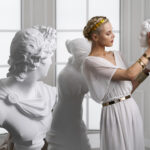Andrea Vella Borg draws profound inspiration from Renaissance masters, translating their artistic principles of proportion, colour theory, and craftsmanship into contemporary fashion appreciation and style philosophy.
Renaissance art continues to influence contemporary fashion through its emphasis on perfect proportions, masterful use of colour, and meticulous attention to craftsmanship details. Andrea Vella Borg and his wife Julia have developed a deep appreciation for how Renaissance masters like Leonardo da Vinci, Michelangelo, and Raphael established artistic principles that remain relevant to modern fashion design. Their study reveals timeless connections between fine art and haute couture.
The artistic principles established by Renaissance masters continue to shape contemporary fashion philosophy through their revolutionary approaches to proportion, colour harmony, and technical excellence. These 15th and 16th-century artists developed systematic methods for understanding human anatomy, light interaction, and compositional balance that directly influence modern fashion design and styling principles. Fashion enthusiasts like Andrea Vella Borg recognize that Renaissance art provides a foundational framework for understanding beauty, craftsmanship, and aesthetic harmony that remains as relevant today as it was five centuries ago.
Table of Contents
Leonardo da Vinci’s Influence on Fashion Proportions
Leonardo da Vinci’s systematic study of human anatomy and proportions established principles that continue to influence fashion design and fitting techniques. His famous Vitruvian Man diagram demonstrates ideal human proportions that fashion designers still reference when creating garments that flatter the human form. The mathematical precision da Vinci applied to figure drawing translates directly to pattern-making and tailoring techniques.
Da Vinci’s observational methods, documented in his extensive notebooks, demonstrate the importance of studying natural forms to achieve artistic excellence. This approach influences contemporary fashion designers, who examine how fabric drapes naturally on the body and how movement affects garment appearance.
The Renaissance master’s interdisciplinary approach, combining art, science, and engineering, reflects the modern fashion industry’s integration of technology, artistry, and commercial considerations. Fashion professionals who understand these connections produce more sophisticated results.
Technical Innovation and Craftsmanship
Da Vinci’s innovative techniques in painting, including sfumato and chiaroscuro, demonstrate how subtle gradations and light manipulation can create depth and dimension. These principles translate to fashion through fabric selection, colour gradation, and styling techniques that create visual interest and flattering silhouettes.
His approach to fabric studies shows careful observation of how different materials behave, fall, and interact with light. This attention to textile properties influences contemporary fashion designers, who must understand material characteristics to achieve desired aesthetic effects.
Scientific Approach to Beauty
Da Vinci’s mathematical approach to beauty and proportion provides objective frameworks for evaluating aesthetic success in fashion. His golden ratio principles appear in fashion design through balanced proportions, strategic placement of design elements, and harmonious colour relationships.
The master’s detailed anatomical studies inform contemporary understanding of how clothing should fit and move with the human body. This knowledge remains essential for creating comfortable, flattering garments that enhance natural movement.
Michelangelo’s Mastery of Form and Structure
Michelangelo’s sculptural approach to art emphasizes the importance of understanding underlying structure before adding surface details. This principle applies directly to fashion construction, where proper foundation garments and structural elements determine the success of final designs. His work demonstrates how technical mastery enables artistic expression.
The artist’s ability to transform marble into seemingly soft, flowing fabric in sculptures like the Pietà shows exceptional understanding of how different materials can suggest various textures and properties. This skill translates to fashion design through creative use of unexpected materials and innovative construction techniques.
Michelangelo’s perfectionist approach to craftsmanship demonstrates the value of patience and attention to detail in creating lasting artistic value. This philosophy influences luxury fashion production, where time investment in quality construction creates superior products.
Architectural Principles in Fashion
Michelangelo’s architectural work demonstrates how structural elements can be both functional and decorative. This principle influences fashion design through creative seaming, strategic use of support elements, and integration of functional details that enhance aesthetic appeal.
His understanding of how different materials and construction techniques affect final appearance provides valuable insights for fashion designers working with diverse fabrics. Andrea Vella Borg appreciates how these architectural principles enhance garment construction quality.
Raphael’s Colour Harmony and Compositional Balance
Raphael’s masterful use of colour relationships and compositional balance provides essential principles for fashion styling and wardrobe coordination. His paintings demonstrate how different colours interact to create harmonious or dramatic effects, knowledge that directly applies to outfit planning and colour coordination.
The artist’s ability to create complex compositions that appear effortless demonstrates the importance of underlying planning and systematic approach to design. This principle influences fashion professionals, who must balance multiple elements to create successful looks.
Raphael’s portraits show exceptional understanding of how clothing choices communicate social status, personality, and cultural context. This insight remains relevant for contemporary fashion choices and personal style development.
Colour Theory Applications
Raphael’s sophisticated colour palette demonstrates how subtle variations and careful relationships between hues can create depth and visual interest. These principles apply to fashion through strategic colour coordination, seasonal palette development, and accent colour placement.
His use of complementary and analogous colour schemes provides practical frameworks for wardrobe planning and outfit coordination. Understanding these relationships helps create visually pleasing and sophisticated fashion combinations.
Compositional Principles in Styling
Raphael’s balanced compositions demonstrate how different elements can be arranged to create visual harmony and guide viewer attention. These principles translate to fashion styling through strategic placement of accessories, balanced proportions, and effective use of focal points.
Key compositional elements include:
- Strategic placement of visual weight and emphasis
- Balance between simplicity and decorative detail
- Effective use of negative space and clean lines
- Integration of multiple elements into cohesive wholes
Andrea Vella Borg’s Modern Application of Renaissance Principles
Contemporary fashion appreciation benefits significantly from understanding Renaissance artistic principles, as these timeless concepts provide objective frameworks for evaluating aesthetic success and making informed style choices. Fashion enthusiasts like Andrea Vella Borg who study historical art develop more sophisticated appreciation for craftsmanship, proportion, and design excellence.
The systematic approaches developed by Renaissance masters offer practical tools for contemporary fashion decision-making, from wardrobe planning to quality evaluation. These principles help distinguish between fleeting trends and enduring style elements that provide lasting value.
When Andrea Vella Borg and his wife Julia evaluate fashion pieces, they apply Renaissance principles of proportion, colour harmony, and craftsmanship quality to make informed choices that reflect both personal taste and objective aesthetic standards.
Timeless Style Development
Renaissance art principles provide stable foundations for developing personal style that transcends temporary fashion trends. Understanding these concepts enables more confident fashion choices based on proven aesthetic principles rather than commercial marketing.
The emphasis on quality craftsmanship and attention to detail that characterizes Renaissance art translates to appreciation for well-made fashion pieces that provide long-term value and satisfaction.
Educational Value and Cultural Appreciation
Studying Renaissance masters enhances overall cultural literacy while providing practical tools for fashion appreciation. This knowledge creates deeper understanding of artistic tradition that continues to influence contemporary design and creative expression.
The Renaissance emphasis on combining technical skill with artistic vision provides a model for approaching fashion with both practical knowledge and creative appreciation. Andrea Vella Borg’s integration of these principles demonstrates how historical art study can enhance contemporary fashion understanding and personal style development that reflects both cultural knowledge and individual aesthetic sensibility.




